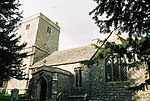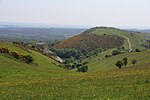Grange Arch
Arches and vaults in EnglandDorset geography stubsFolly buildings in EnglandGrade II* listed buildings in Dorset

Grange Arch, also known as Creech Folly, is an 18th-century folly that is located near the second highest point of the Purbeck Hills, Ridgeway Hill (199 m), in Dorset. It lies within the parish of Steeple. The folly, which was built by a former owner of Creech Grange, Denis Bond, in 1746, is built in the form of a triple arch of ashlar stone. The central archway is surmounted by battlements and flanked by stone walls with smaller doorway arches.Today the arch is owned by the National Trust. English Heritage have designated it a Grade II* listed building.
Excerpt from the Wikipedia article Grange Arch (License: CC BY-SA 3.0, Authors, Images).Grange Arch
Grange Hill,
Geographical coordinates (GPS) Address External links Nearby Places Show on map
Geographical coordinates (GPS)
| Latitude | Longitude |
|---|---|
| N 50.6356 ° | E -2.1249 ° |
Address
Grange Arch
Grange Hill
BH20 5DF , Steeple with Tyneham
England, United Kingdom
Open on Google Maps










